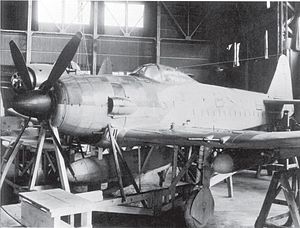| J6K1 Jinpu | |
|---|---|

| |
| Role | Interceptor aircraftType of aircraft |
| National origin | Japan |
| Manufacturer | Kawanishi Aircraft Company |
| Status | design only |
| Primary user | Imperial Japanese Navy Air Service (intended) |
| Number built | 0 |
| Developed from | Kawanishi J3K |
The Kawanishi J6K1 Jinpu ("Squall") was an interceptor fighter design developed by the Japanese company Kawanishi Kōkūki KK in the early 1940s. It was based on the earlier Kawanishi J3K.
Design and development
The J6K1 was an improved version of the J3K1 with a more powerful engine. Instead of using the Mitsubishi MK9A, it used the Nakajima NK9A Homare 42 engine. The design reached the mockup phase, but not long before the worsening war situation prompted its cancellation in 1944.
Specifications (J6K1 as designed)
Data from
General characteristics
- Crew: 1
- Powerplant: × Nakajima NK9A Homare 42 18-cylinder two-row air-cooled radial piston engine, 1,600 kW (2,200 hp)
- Propellers: 4-bladed constant-speed propeller
Performance
Armament
- Guns:
- 2× 13.2 mm (0.520 in) Type 3 aircraft machine guns
- 2× 30 mm (1.181 in) Type 5 cannon
See also
Aircraft of comparable role, configuration, and era
- Fiat G.55 Centauro
- Hawker Tempest
- Kawanishi N1K2-J
- Kawasaki Ki-100
- Lavochkin La-7
- Messerschmitt Bf 109G
- Mitsubishi J2M3
- North American P-51D Mustang
- Reggiane Re.2005 Sagittario
- Republic P-47N Thunderbolt
Related lists
- List of aircraft of Japan during World War II
- List of aircraft of World War II
- List of fighter aircraft
- List of military aircraft of Japan
References
- "Kawanishi J6K1 Jinpu (Squall)". www.historyofwar.org. Retrieved 8 March 2019.
- Francillon, Rene (March 1987). Japanese Aircraft of the Pacific War (2nd (American) ed.). Annapolis: Naval Institute Press. p. 490. ISBN 978-0870213137.
| Kawanishi and Shin Meiwa/ShinMaywa aircraft | |
|---|---|
| Fighters | |
| Flying boats |
|
| Reconnaissance seaplanes | |
| Trainers | |
| Suicide attack aircraft | |
| Civil aircraft | |
| WWII Allied reporting names | |
| Shin Meiwa/ShinMaywa aircraft | |
| Imperial Japanese Navy aircraft designations (short system) | |
|---|---|
| Fighters (A) | |
| Torpedo bombers (B) | |
| Shipboard reconnaissance (C) | |
| Dive bombers (D) | |
| Reconnaissance seaplanes (E) | |
| Observation seaplanes (F) | |
| Land-based bombers (G) | |
| Flying Boats (H) | |
| Land-based Fighters (J) | |
| Trainers (K) | |
| Transports (L) | |
| Special-purpose (M) | |
| Floatplane fighters (N) | |
| Land-based bombers (P) | |
| Patrol (Q) | |
| Land-based reconnaissance (R) | |
| Night fighters (S) | |
| X as second letter is for experimental aircraft or imported technology demonstrators not intended for service, Hyphenated trailing letter (-J, -K, -L, -N or -S) denotes design modified for secondary role, Possibly incorrect designation, but used in many sources | |
| Imperial Japanese Navy official aircraft names | |||||||||
|---|---|---|---|---|---|---|---|---|---|
| Fighters |
| ||||||||
| Heavy bombers | |||||||||
| Bombers | |||||||||
| Patrol | |||||||||
| Reconnaissance | |||||||||
| Trainers | |||||||||
| Transports | |||||||||
| Miscellaneous | |||||||||
| Special-purpose aircraft | |||||||||
| With some exceptions for rockets, jets and repurposed aircraft, names chosen were for: 1. Winds, 2. Lightning, 3. Nighttime lights, 4. Mountains, 5. Stars/constellations, 6. Seas, 7. Clouds, 8. Plants, 9. Skies, 10. Landscapes, and 11. Flowers. Published translations disagree, and many are simplified, especially for plants, where the Japanese referred to a specific variety and the common translations only to the broader type. | |||||||||